|
Command Activation
| Ctrl +
n |
Measure→Auto Features→Cone Generator |
|
| Keyboard |
Main Menu |
Toolbar |
Definition
The Cone Generator will build and tolerance Cone features. This
allows building of offline features when not connected to a coordinate
measuring machine or when the production part is not available. The Cone
Generator also builds all motion paths and can execute on demand the
measuring of the new cone.
The Cone Generator provides complete access to size, location, start
/ stop angles and motion path generators required to measure the feature.
The tool has two functions. The first is to create a new feature. The second
provides access to editing an existing feature whether created by the
generator or manually taught.
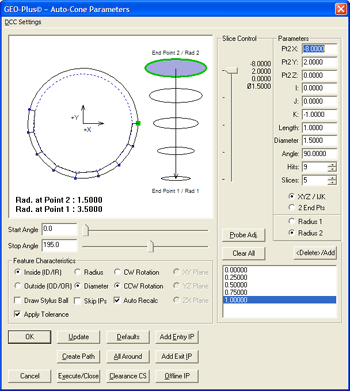 |
| figure 1,
The Cone Generator |
Using the Cone Generator to Create a New Feature
To create a new feature, activate the generator and follow these steps:
Step 1 - Feature Characteristics
Complete the selections in the Feature Characteristics Group
- Choose the "anchor" Radius with is identified as Radius 1 / Radius 2
- Select Inside or Outside feature type.
- Choose reporting format, Radius or Diameter.
- Choose probing direction, Clockwise or Counter-Clockwise.
Step 2 - Feature Parameters
Complete the values required in the Parameters Group
- Enter the XYZ center point of the anchor radius.
- Enter the Radius or Diameter nominal value of the
anchor radius.
- Enter the direction vector that starts at the anchor radius.
- Enter the length of the cone.
- Select the number of hits required.
- Select the number of slices required.
NOTE: when entering the XYZ end points it is
important that you establish a probing depth sufficient to clear chamfers
and edges. You can enter the XYZ end points based on the total length of the
cone, then use <Probe Adj.> which will reduce the end
points along the axis vector 125% of one probe radius. This ensures the
probe will have clearance at the ends for the probe.
Step 3 - Motion Path Adjustments
There are several tools available to build motion
paths to ensure clear motion without collision into the inspection part,
clamps and other obstacles. These include Clearance Coordinate Systems,
offline IPs and Automatic IPs.
Slice Control
 |
|
figure 2, Slice Control |
The Cone Generator uses slices along the cone
to capture data points. If the hit count is set to 10 and the slice count is
at 5, then there are a total of 50 data points. The slices are created
equally over the distance from end point one to end point two.
To change the slice count, use the Up/Down arrows in
the slice control, or enter a new value. As you click on the arrows, the
graphic will update showing the new slice count.
If the cone has a groove in it, a slice may pass
over that groove which would create a poor fit. To prevent this, locate the
slice in the list and press the <Delete>/Add button, or double click. The
slice will highlight and be removed from the path generation.
Creating Offline IPs and Automatic IPs
Once the Clearance Coordinate System has been
established and set active, Offline IPs can be generated to build a motion
path for safe CMM travel,
see Offline IP Generator.
Special Interim Point Commands
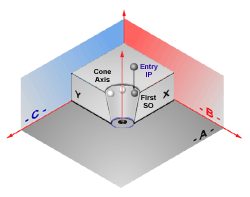 |
| figure 3, Entry IP |
In most applications, the use of the command <Add
Entry IP> and <Add Exit IP> will ensure safe transition for your CMM into
and out of features. The use of these commands requires that a
Clearance CS
is currently set active. For a cone, the Entry and Exit IPs will move
parallel to the axis of the cone, see figure 3.
The Add Entry IP command will calculate an IP from the
first SO along the axis of the cone into the Clearance CS XY base plane.
Referring to the illustration at right, the first Standoff Point is
extracted and projected into the XY Base plane of the active Clearance CS.
The motion will start directly over the cone opening and plunge to the first SO
safely.
The Add Exit IP command creates a similar IP to Add
Entry IP except it will use the last SO as the reference.
Miscellaneous Functions
<All Around>
This will recalculate the motion to measure all around the circle. When
there are 4 data points, each data point will measure at:
- Data Point #1 - 0°
- Data Point #2 - 90°
- Data Point #3 - 180°
- Data Point #4 - 270°
The motion path generator will determine optimal path including the
insertion of IPs between data points to prevent collision with the part.
This is especially important when measuring outside diameters.
<Defaults>
This command is not available for the Cone Generator.
Interpreting the Graphical Display
A cone can be orientated in any direction within a 3D space. This
makes it difficult to use a 2D display to properly represent it.
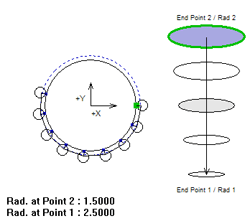 |
|
figure 4, As shown in Cone Generator |
 |
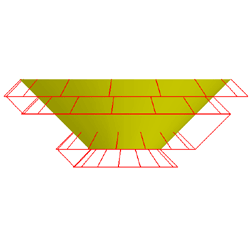 |
| figure 5, Viewed from the top. |
figure 6, Viewed from the side. |
In figure 4, the top and side is shown in the Cone
Generator. Figures 5 and 6 is the final solution shown in the inspection report
showing the motion path also from the top and side. As you can see, there is
one slice deleted and
the path reverses direction between CW and CCW with each slice.
In the Cone Generator, the CMM axis directions are shown, here they are +X /
+Z and the data points are captured on the top to allow clearance for the
probe shank. With some practice, you will understand the intricacies of
building an efficient and safe motion path.
XYZ versus IJK
A cone can be defined using the axis, known as the IJK or by
using two XYZ end points. Which one you choose is determined by the cone
characteristics. In most cases, using the IJK method will provide provide an
easy method to build the cone.
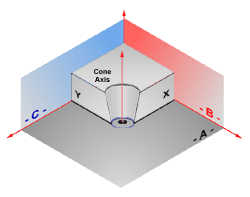 |
| figure 7, IJK Cone definition |
The IJK starts at the center of the specified anchor
radius and its direction determines the direction of the cone. Using the
example shown in figure 7, we have a cone with a 0.500" radius at the PCS
of Z = 0.000". The cone opens upward top the top of the block which is
Z=1.250".
To build this cone, start by choosing Radius 1 which moves the
anchor of the IJK to the lower radius. Radius 1 is considered the smaller radius
for all cone generations. Entered its XYZ location where Radius 1 exists in the
PCS. Here we will use X:2.000", Y-2.000", Z:0.000"
Ensure you have selected both the "Inside (ID/IR)"
"Radius" bullets in Feature Characteristics. Next enter 0.500" in the Radius
data field.
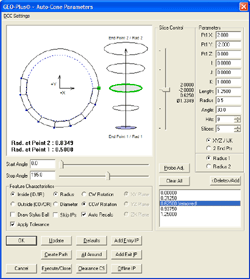 |
| figure 8, Cone Generator Example |
Our final cone opens upward and is perpendicular to the
PCS XY base plane. The IJK values that should be entered are I:0.000,
J:0.000, K:1.000. The height of the block is 1.25" which corresponds to the
length of the cone. Enter 1.250" in the Length data field.
The final Parameter needed for the cone is the Included Angle.
In this example, enter 30.0 in the Angle data field.
As you change data fields, they highlight to shown changes
made to parameters and they become applied when you press the <Update>
button. Should any value be outside acceptable limits, the data field will
highlight in a red color and a message will appear instructing you to correct
the value.
In figure 8, we show the data fields all filled in. This cone
is measured with a reduced start and stop angles. The start angle is 0.0° which
is along the X axis when defined in the PCS XY base plane. The stop angle is
195°. The direction is controlled by the Clockwise (CW) or Counter-Clockwise
(CCW) selection. By default the direction is CW but can be switch by placing a
bullet next to CCW as we have done here.
|





